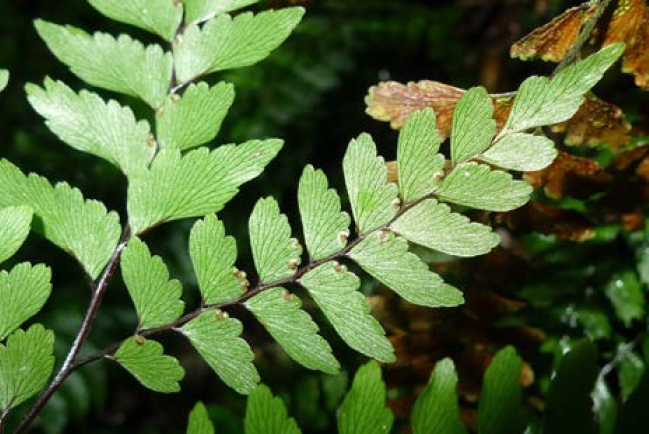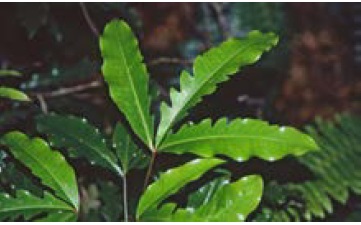Trip Report – 2 August 2014 : Porirua Scenic Reserve
A forecast of gale northerlies and rain did not deter 17 participants (mostly members, but with a few extras). In any case, we were on the leeward side of a hill and under tallish forest; a little dark but otherwise good winter botanising.
 |
| Adiantum viridescens is uncommon in the Wellington region. Photo: Leon Perrie. |
Porirua Scenic Reserve is one of the best forest remnants I’ve seen in the Wellington area. Admittedly, I may be biased given the lush groundcover is dominated by ferns (particularly
Blechnum filiforme and
Microsorum scandens). It reminds me of the northern North Island forests of my formative botanical years. The coastal/lowland influence is strong, with the canopy largely kohekohe. This was fruiting abundantly, as was the nikau.
We climbed the main track which begins next to Camp Elsdon on Raiha Street. Although steep in places, the track is well-formed and, traversing the side of a gully, provides excellent viewing of the underside of the canopy trees growing in the gully. The track reaches into upland scrub in the south-western corner of the reserve, which is where we turned around. From there, it is possible to walk through farmland to Colonial Knob itself and/or to DOC’s nearby Colonial Knob Scenic Reserve. Porirua Scenic Reserve is administered by Porirua City Council.
With 156 hectares, there are other opportunities for future exploring on subsidiary tracks (which are not mapped on the official brochures).
Porirua Scenic Reserve has been well-botanised previously (see species list on NZPCN website, principally by Pat Enright). We made few additions:
Hypochaeris radicata (catsear) and
Iris foetidissima (stinking iris), along with bellbird and falcon.
Highlights included: one
Raukaua edgerleyi (raukawa), c. 4 cm d.b.h., epiphytic on
Cyathea smithii (katote) and previously noted only from a different part of the reserve; large
Laurelia novaezelandiae (pukatea);
Ileodictyon cibarium (common basket fungus); and the fern
Adiantum viridescens, which is uncommon in the Wellington region. We noted, near the entrance, trackside seedlings of
Prumnopitys taxifolia (matai) and
Podocarpus totara (totara), some of which may be planted while others looked self-sown. Seedlings of
Corynocarpus laevigatus (karaka) were abundant in places, but we did not note many (if any) large individuals.
 |
Leaf of juvenile Raukaua edgerleyi.
Photo: Jeremy Rolfe. |
We wondered if the poor development of the forest tiers between canopy and groundcover reflected earlier browsing pressure. However, testament to the success of the current pest control were the numerous (and vocal) tui, abundant kohekohe and nikau fruit set, and lush groundcover which included carpets of nikau seedlings in places. Chris Horne asked Glen Falconer, Team Leader, Pest Animal, Greater Wellington Regional Council, to comment on this: “pest animal control began in 1996, but more intensive management started in 2001 and continues today targeting possums, rats and mustelids. There are approximately 214 bait stations and 31 DOC200 traps in the council reserve and adjoining privately owned Mill Creek. Pikarere Farm also has possum and mustelid control in place to try to slow down re-invasion from the southwest. Self-introductions of kakariki, whitehead and bellbirds occurred about 2003-04. Rodent and bird monitoring occurs at the site.”
We’re lucky to have this biodiversity treasure on our doorstep. We also now know it makes a good (botanical) port in a winter storm. The rain set in as we departed the car park.
Participants : Gillian Candler, Barbara Clark, Gavin Dench, Ian Goodwin, Jill Goodwin, Mark Harris, Rick Holmes, Chris Hopkins, Chris Horne, Barbara Mitcalfe, Chris Moore, Mick Parsons, Leon Perrie (co-leader, scribe), Lara Shepherd (co-leader), Sunita Singh, Roy Slack, Adrian Still.

 Site Index
Site Index







 Site Index
Site Index





